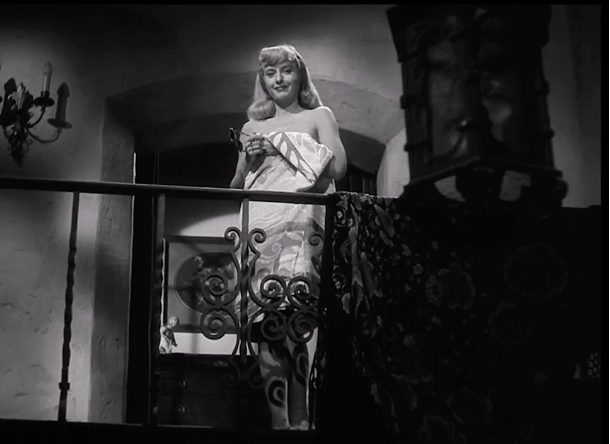Seeing the Light in “Double Indemnity”
Double Indemnity
1944 Director: Billy Wilder
Starring: Fred MacMurray, Barbara Stanwyck, Edward G. Robinson
Insurance salesman Walter Neff (MacMurray) arrives at his office at dawn with a fatal gunshot wound and narrates a confession into a Dictaphone, revealing his role in a murder. It began innocently, though, as he sought to renew a car insurance policy for the Pacific All Risk Insurance Company. In a flashback, he visits an elegant Spanish-style home in Los Angeles, where he is instantly smitten with Phyllis Dietrichson (Stanwyck). At a later meeting, she contemplates life insurance for her husband without him knowing it, but Walter immediately realizes that she wants to assassinate her spouse. Although Walter refuses to participate, his attraction to her leads him back. The pair con Dietrichson (Tom Powers) into signing a policy offering a double payout should his death occur accidentally, setting off a web of intrigue, despair, and regret.
“Double Indemnity” is an important film noir that became a template for many cinematic genres. It is a haunting story of seduction, betrayal, and murder that resonates many decades after its release. Light plays an important role in this movie, particularly in the Dietrichson living room, as sunlight streams dramatically through the venetian blinds and onto the dark walls. At least one writer interprets this lighting as a symbol for prison bars, but I disagree because no one is incarcerated and, most obviously, because the light streams are horizontal and not vertical.1
Upon arrival, Walter describes his surroundings, as he waits to meet Phyllis: “The living room was still stuffy from last night’s cigars. The windows were closed and the light coming in through the venetian blinds showed the dust in the air.” The room then, is unclean—impure—even though at least two women are present there, and one is a housekeeper! Home is traditionally a safe haven and a living room is usually a place to “live” in comfort, but the schemes hatched in this one will be deadly. Actually, the soft, warm sunlight falling across the walls at first seems welcoming, but it is as deceptive as most of the characters that inhabit this story.
Phyllis—the quintessential femme fatale—emerges at the upstairs landing in radiant luminosity and introduces herself to Walter. She is dressed only in a towel. She has been sunbathing and is actually “bathed in light” in this scene. At her first appearance overhead, Phyllis might just be a beautiful blonde angel. She has a warm, attractive aura. But as mentioned, this is a deception. This saint quickly reveals herself as a sinner, appearing nearly nude and ready for seduction: she is scantily clad, smiling seductively and imperiously at Walter below. She then dresses and joins him downstairs, where she alternatingly flirts with and discourages him. She is the bright spot in his life, but she is destructive.
Another symbolic use of light in this drama is the lighting of cigarettes. Smoking was fashionable in the 1940s and appears often in noir and other films, at times representing sexual encounters. The motif is so embedded in the era that, when Barton Keyes (Robinson) has problems with a match, Walter lights the cigar for his unappreciative boss then chides him: “I love you, too.” Only the striking of the match is emphasized in various scenes here, rather than smoking. Usually, Walter lights the match by scratching it with his fingernail, something that must require considerable practice. He lights matches frequently, as everyone smokes. As noted, Walter aids Keyes with this action repeatedly, which becomes an indicator of his abilities in general, a representation of his shrewdness, strength, and vigor. . . except later, where the roles are reversed.
Light often represents truth but truth is hidden in noirs. This is symbolized when Phyllis hides her eyes—the windows of the soul—with sunglasses when she meets Walter at the market. The eyewear is unnecessary except as a disguise indoors, as sunlight is absent at the store. They have avoided each other to quell suspicion, but must meet now due to complications in their scheme. In this iconic scene, Phyllis’s face is marmoreal, not only in its lack of expression, but also in its paleness.
Much of “Double Indemnity” occurs in darkness. And its night scenes often reveal more facts than the daylight. The sinister mood here is rarely alleviated with light; quite the contrary.
Copyright © 2024 by Rosi Prieto, Ph.D.
All Rights Reserved
https://avanidoel.weebly.com/double-indemnity.html






